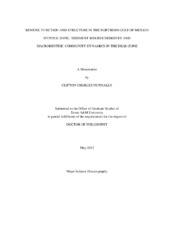| dc.contributor.advisor | Rowe, Gilbert T. | |
| dc.creator | Nunnally, Clifton | |
| dc.date.accessioned | 2012-07-16T15:58:24Z | |
| dc.date.accessioned | 2012-07-16T20:31:10Z | |
| dc.date.available | 2014-09-16T07:28:21Z | |
| dc.date.created | 2012-05 | |
| dc.date.issued | 2012-07-16 | |
| dc.date.submitted | May 2012 | |
| dc.identifier.uri | https://hdl.handle.net/1969.1/ETD-TAMU-2012-05-11040 | |
| dc.description.abstract | Coastal low oxygen areas are expanding globally and are predicted to increase in size and duration due to climatic changes associated with a warming ocean. The Gulf of Mexico Hypoxic Zone (GoMHZ) is the second largest regularly occurring hypoxic habitat in the world and has increased in size since it was first mapped in the 1980s. The Mississippi Atchafalaya River System (MARS) floods the Louisiana continental shelf with fresh water high in nitrogenous compounds enhancing primary production which sinks to the sea floor. Stratification that occurs as a result of density differences and coastal currents creates a strong pycnocline that prevents bottom waters from being aerated causing seasonally hypoxic bottom waters (< 2.0 mg L^-1). The Mechanisms Controlling Hypoxia (MCH) project (hypoxia.tamu.edu) made regular cruises during 2004-2005 and 2007-2009 to the GoMHZ performing shelf wide hydrographic surveys and occupying central mooring sites within theoretical zones of differing hypoxic potential. Sediment cores were collected for incubation experiments using Batch Microincubation Chambers (BMICs) to measure rates of sediment community oxygen consumption and nutrient regeneration. Results of incubation experiments characterized sediments as net sources of dissolved inorganic nitrogen, mostly ammonium, and silicate and a net sink of phosphate. Modeling simulations of benthic-pelagic coupling focused in the western study zones related field measurements of benthic nutrient regeneration and primary production to important processes that maintain summertime hypoxia when surface waters are nitrogen limited. After incubations were completed macrofaunal individuals were removed from the cores enumerated and identified to the lowest possible taxon. Macrofauna communities in 2004-2005 were dominated by a hypoxia tolerant community dominated by polychaetes. Hurricanes Katrina and Rita in August and September of 2005 drastically reorganized macrobenthic communities decreasing abundances and negatively impacting diversity. These new communities collapsed under hypoxic stresses potentially impacting the ability of demersal foragers to utilize an important food resource. Large variations in biogeochemical fluxes and patchy distribution of fauna impeded the delineation of significant zones in benthic function and structure. | en |
| dc.format.mimetype | application/pdf | |
| dc.language.iso | en_US | |
| dc.subject | hypoxia | en |
| dc.subject | Louisiana continental shelf | en |
| dc.subject | sediment community oxygen consumption | en |
| dc.subject | sediment nutrient regeneration | en |
| dc.subject | macrofauna | en |
| dc.subject | hurricane | en |
| dc.title | Benthic Function and Structure in the Northern Gulf of Mexico Hypoxic Zone: Sediment Biogeochemistry and Macrobenthic Community Dynamics in the Dead Zone | en |
| dc.type | Thesis | en |
| thesis.degree.department | Oceanography | en |
| thesis.degree.discipline | Oceanography | en |
| thesis.degree.grantor | Texas A&M University | en |
| thesis.degree.name | Doctor of Philosophy | en |
| thesis.degree.level | Doctoral | en |
| dc.contributor.committeeMember | Quigg, Antonietta | |
| dc.contributor.committeeMember | Thornton, Daniel C. | |
| dc.contributor.committeeMember | Dellapenna, Timothy | |
| dc.type.genre | thesis | en |
| dc.type.material | text | en |
| local.embargo.terms | 2014-07-16 | |


